I am trying to plot a binary regression line with ggplot and a real dataset for practice. The question: Is distance in kilometers a predictor for choosing a car as means of transport to get to the soccer stadium.
The variable A2 was dichotomized (1 = Auto (car) and 0 = kein Auto (no car)) and is now called A2_auto
dataset %>%
mutate(A2_auto = car::recode(.$A2,
"1 = 1; 2:9 = 0",
as.factor = FALSE)) -> dataset
dataset$A2_auto <- factor(dataset$A2_auto, labels = c("kein Auto",
"Auto"))
After I have calculated the coefficients of determination (significant but very low Odd-Ratio) I wanted to plot the regression curve with ggplot:
ggplot(data=dataset, aes(x=A21, y=A2_auto)) +
geom_point(alpha=.5) +
stat_smooth(method="glm.fit", se=FALSE, method.args = list(family=binomial))
But I receive a Warning Message:
>`geom_smooth()` using formula 'y ~ x'
Warnmeldung:
Computation failed in `stat_smooth()`:
Unused Argument (data = data)
There is no regression line in the Scatterplot. Can't figure out why:
Here is the structure of the dataframe:
'data.frame': 689 obs. of 3 variables:
$ A2 : dbl+lbl [1:689] 1, 1, 6, 6, 6, 7, 7, 7, 7, 7, 7, 7, 7, 7, 8, 8, 8, 8, 8, 8, 8, 8, 6, 6, 6, 6, 7, 7, 7, 7, 7, 7, 7, 7, 7, 7, 7, 7, 7, 7, 6, 7, 7, 3, 6, 6, 6, 6, 6, 6, 6...
..@ label : chr "Mit welchem Verkehrsmittel legen Sie die größte Distanz zum Stadion zurück, wenn Sie ein Bundesliga-Heimspiel b"| __truncated__
..@ format.spss : chr "F40.0"
..@ display_width: int 0
..@ labels : Named num 1 2 3 4 5 6 7 8 9
.. ..- attr(*, "names")= chr [1:9] "PKW" "Bahn (Fernverkehr)" "Bahn (Nahverkehr)" "Fernbus" ...
$ A21 : num 1 1 1 1 1 1 1 1 1 1 ...
..- attr(*, "label")= chr "Distanz in km"
..- attr(*, "format.spss")= chr "F8.2"
..- attr(*, "display_width")= int 0
$ A2_auto: Factor w/ 2 levels "kein Auto","Auto": 2 2 1 1 1 1 1 1 1 1 ...
Thanks for the help!
Edit1: Here is the output of dput(head(dataset,50)):
structure(list(A2 = structure(c(1, 1, 6, 6, 6, 7, 7, 7, 7, 7,
7, 7, 7, 7, 8, 8, 8, 8, 8, 8, 8, 8, 6, 6, 6, 6, 7, 7, 7, 7, 7,
7, 7, 7, 7, 7, 7, 7, 7, 7, 6, 7, 7, 3, 6, 6, 6, 6, 6, 6), label = "Mit welchem Verkehrsmittel legen Sie die größte Distanz zum Stadion zurück, wenn Sie ein Bundesliga-Heimspiel besuchen? - Selected Choice", format.spss = "F40.0", display_width = 0L, labels = c(PKW = 1,
`Bahn (Fernverkehr)` = 2, `Bahn (Nahverkehr)` = 3, Fernbus = 4,
`Fan-/Reisebus` = 5, ÖPNV = 6, Fahrrad = 7, `Zu Fuß` = 8, Sonstige = 9
), class = c("haven_labelled", "vctrs_vctr", "double")), A21 = c(1,
1, 1, 1, 1, 1, 1, 1, 1, 1, 1, 1, 1, 1, 1, 1, 1, 1, 1, 1, 1, 1,
2, 2, 2, 2, 2, 2, 2, 2, 2, 2, 2, 2, 2, 2, 2, 2, 2, 2, 4, 4, 4,
6, 6, 6, 6, 6, 6, 6), A2_auto = structure(c(2L, 2L, 1L, 1L, 1L,
1L, 1L, 1L, 1L, 1L, 1L, 1L, 1L, 1L, 1L, 1L, 1L, 1L, 1L, 1L, 1L,
1L, 1L, 1L, 1L, 1L, 1L, 1L, 1L, 1L, 1L, 1L, 1L, 1L, 1L, 1L, 1L,
1L, 1L, 1L, 1L, 1L, 1L, 1L, 1L, 1L, 1L, 1L, 1L, 1L), .Label = c("kein Auto",
"Auto"), class = "factor")), row.names = c(NA, 50L), class = "data.frame")
When I change the model from glm.fit to glm another Warning Message is coming up:
ggplot(data=dataset, aes(x=A21, y=A2_auto)) +
geom_point(alpha=.5) +
stat_smooth(method="glm", se=FALSE, method.args = list(family=binomial))
Output:
`geom_smooth()` using formula 'y ~ x'
Warnmeldungen:
1: glm.fit: algorithm did not converge
2: Computation failed in `stat_smooth()`:
y values must be 0 <= y <= 1
I also dichotomized the variable to 0 and 1 (without factors) and the same error occurs:
dataset %>%
mutate(A2_auto = car::recode(.$A2,
"1 = 1; 2:9 = 0",
as.factor = TRUE)) -> dataset
`geom_smooth()` using formula 'y ~ x'
Warnmeldungen:
1: glm.fit: algorithm did not converge
2: Computation failed in `stat_smooth()`:
y values must be 0 <= y <= 1
I`ll try to make my example reproducible with mtcars as suggested in the comments.

